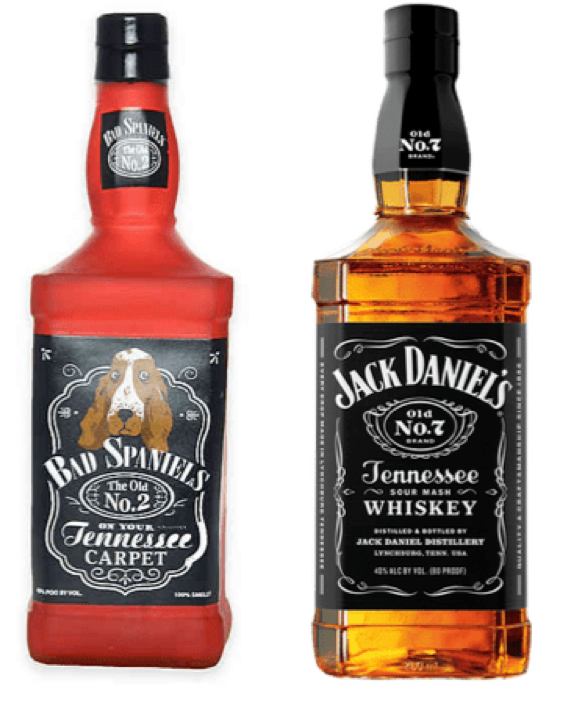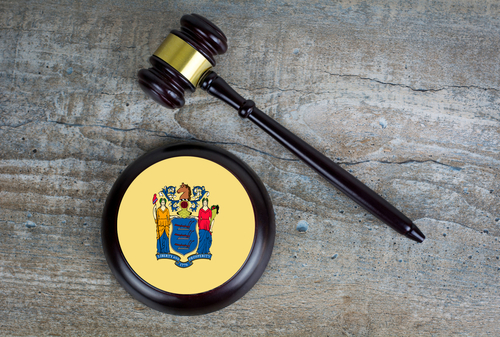Jack Daniel’s Gets Last Laugh for Now in SCOTUS’ Ruling in ‘Bad Spaniels’ Case
“Without deciding whether Rogers has merit in other contexts, we hold that it does not when an alleged infringer uses a trademark in the way the Lanham Act most cares about: as a designation of source for the infringer’s own goods.” – U.S. Supreme Court
Source: Court documents
The U.S. Supreme Court held today in Jack Daniel’s Properties v. VIP Products that the Rogers test, used to “protect First Amendment interests in the trademark context,” is not relevant “when an alleged infringer uses a trademark as a designation of source for the infringer’s own goods.” The Court therefore vacated the U.S. Court of Appeals for the Ninth Circuit’s ruling that said VIP’s dog toy mimicking a Jack Daniel’s whiskey bottle was an expressive work entitled to First Amendment protection. Justice Kagan authored the unanimous opinion for the Court, while Justice Sotomayor, joined by Justice Alito, and Justice Gorsuch, joined by Justices Thomas and Barrett, each filed concurring opinions.
Dogs in the Fight
In its ruling in 2020, the Ninth Circuit said VIP’s dog toy mimicking a Jack Daniel’s whiskey bottle was an expressive work entitled to First Amendment protection, reversing the district court’s initial holding that the toy infringed and diluted Jack Daniel’s marks and remanding the case back to the district court for a determination on the merits of the infringement claim. Jack Daniel’s had previously petitioned the High Court in January of 2021, but that petition was denied. VIP in part argued at the time that Supreme Court review was unwarranted at the interlocutory stage.
But in November 2022, the Court granted Jack Daniel’s second petition, which presented two questions for review:
- Whether humorous use of another’s trademark as one’s own on a commercial product is subject to the Lanham Act’s traditional likelihood-of-confusion analysis, or instead receives heightened First Amendment protection from trademark-infringement claims.
- Whether humorous use of another’s mark as one’s own on a commercial product is “noncommercial” under 15 U.S.C. § 1125(c)(3)(C), thus barring as a matter of law a claim of dilution by tarnishment under the Trademark Dilution Revision Act
In oral arguments held earlier this year, Jack Daniel’s counsel, Lisa Schiavo Blatt of Williams & Connolly, said that the Rogers’ test was invented for movie titles and is not aptly applied here, and should ultimately be scrapped. “There’s no way to keep Rogers and be faithful to the text,” Blatt said. The Lanham Act has no exceptions for expressive works, and “artistic relevance”, which is articulated in the Rogers test, has nothing to do with confusion, Blatt said.
But VIP countered that iconic brands are a kind of celebrity and people are constitutionally entitled to make fun of celebrities. “Bad Spaniels is a parody playfully comparing Jack to man’s other best friend,” VIP’s counsel, Bennett Evan Cooper of Dickinson Wright, said. Ultimately, Jack Daniel’s complaint is about the poop-related aspects of the toy and not the use of the mark, he added. “Companies simply do not license lampoons of their own products,” so there can be no confusion.
It’s All About Source
However, today, the Supreme Court clarified that First Amendment considerations under Rogers are not appropriate as a threshold test “when the accused infringer has used a trademark to designate the source of its own goods—in other words, has used a trademark as a trademark.” During oral argument the justices had implied that the parties could have sought a narrower path to success than either was proposing, with Jack Daniel’s seeking to throw Rogers out completely, on the one hand, and VIP asking to considerably broaden the test’s scope. In its ruling, the Court addressed this, explaining that the parties chose to address the issue in “the broadest possible way, either attacking or defending Rogers in all its possible applications.” The decision continued:
“Today, we choose a narrower path. Without deciding whether Rogers has merit in other contexts, we hold that it does not when an alleged infringer uses a trademark in the way the Lanham Act most cares about: as a designation of source for the infringer’s own goods.”
While that means the likelihood of confusion analysis should be applied, it does not mean VIP’s cause is lost, said the Court. “Beyond source designation, VIP uses the marks at issue in an effort to ‘parody’ or ‘make fun’ of Jack Daniel’s,” wrote the Court. “And that kind of message matters in assessing confusion because consumers are not so likely to think that the maker of a mocked product is itself doing the mocking.”
The Court next detailed the history of the Rogers test to demonstrate that it “has always been a cabined doctrine” that has been applied only to cases in which “the defendant has used the mark” at issue in a “non-source-identifying way.” Since VIP conceded that it uses the mark in a source identifying manner, Rogers cannot apply.
As to dilution, the Court said, “the use of a mark does not count as noncommercial just because it parodies, or otherwise comments on, another’s products.” This was the easier of the two issues to decide, said the Court. Like the fair use exclusion of the Lanham Act, the exclusions from dilution liability for any noncommercial use of a mark “[do] not apply when the use is ‘as a designation of source for the person’s own goods or services,’” wrote the Court. The Ninth Circuit’s “expansive view of the ‘noncommercial use’ exclusion effectively nullifies Congress’s express limit on the fair-use exclusion for parody, etc.,” said the Court.
More to Consider
However, the Court made it clear that its decision is narrow and that there are additional issues for the court to consider on remand.
In his concurrence, Justice Gorsuch wrote to “underscore that lower courts should handle Rogers v. Grimaldi…with care,” since the majority’s decision necessarily leaves much about the Rogers test “unaddressed.” He explained:
“For example, it is not entirely clear where the Rogers test comes from—is it commanded by the First Amendment, or is it merely gloss on the Lanham Act, perhaps inspired by constitutional-avoidance doctrine? For another thing, it is not obvious that Rogers is correct in all its particulars—certainly, the Solicitor General raises serious questions about the decision…. All this remains for resolution another day…and lower courts should be attuned to that fact.”
And in a separate concurrence, Justice Sotomayor wrote to caution against relying too heavily on survey results “in the context of parodies and potentially other uses implicating First Amendment concerns.” Survey evidence was a major factor in the district court’s decision in the case.
Reaction
“The Court’s decision will be extremely welcome news to brand owners,” said J. Michael Keyes, of Dorsey & Whitney.
Keyes said the decision will be especially appreciated by “established, mature brands that need to fend off other users and copyists in the marketplace.”
He added that the ruling is consistent with the Court’s recent analysis in Andy Warhol Foundation v. Goldsmith, Lynn, et. al., where the rights holder also prevailed. “It may be indicative of a broader trend of the Court protecting IP owners and looking more askance at those that copy and imitate those protected works,” Keyes said.
Nicole Haff of Michelman & Robinson said the decision could have a significant impact on businesses built on parody. “There are many businesses whose entire business model is based on creating product lines that mock famous brands,” Haff said. “In the wake of this decision, those businesses should promptly reevaluate their product lines.”
Others pointed out that Rogers is far from dead following this opinion. Michael Palmisciano of Sullivan & Worcester said the Court simply “preserved Rogers as it was originally intended.” He added: “Rogers continues to afford creators great leeway to use third-party marks in titles of artistic works for purposes of parody, commentary and criticism.”






